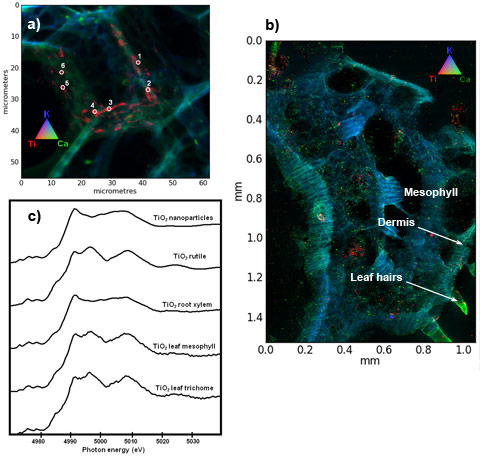- Home
- News
- Spotlight on Science
- Uptake of titanium...
Uptake of titanium dioxide nanoparticles by cucumber plants probed by submicrometre X-ray microspectroscopy
26-11-2012
Nanoparticular titanium dioxide is one of the most commonly used nanomaterials. In this study, the speciation and distribution of titanium in cucumber plants exposed to titanium dioxide nanoparticles were investigated to determine whether the nanoparticles could enter into the food chain via agricultural products.
Share
Nanoparticles are widely used due to their special properties stemming from their surface area, shape, electronic, and optical behaviour. Their size is typically between 1 and 100 nm for at least two of their dimensions [1]. One of the most commonly used nanomaterials is nanoparticular TiO2. These nanoparticles are used in sunscreens, antibacterial and antiviral disinfectants, organic pollutant removers, gas sensors [3] and solar cells [4]. However, the increasing number of applications for nanoparticular TiO2 raises concern about potential negative environmental and health effects related to exposure to these kind of materials.
The fate and transport of mixed anatase-rutile TiO2 nanoparticles in cucumber plants was studied by means of X-ray microspectroscopy at beamline ID21 where a submicrometre focused beam (using Fresnel zone plates) permits detailed studies on the distribution and speciation of nanoparticles in biological tissues. X-ray fluorescence (XRF) mapping of Ti in the root tissues showed that Ti does indeed reach the transport vessels (xylem) in the roots (Figure 1a). X-ray absorption spectroscopy (XANES) confirmed that Ti is present as TiO2 with the same anatase-rutile ratio as in the parent material (Figure 1c). Results on the leaf tissues (Figure 1b) showed that Ti is localised in dermis, mesophyll and even in the leaf hairs (trichomes). Surprisingly, XANES results showed that the Ti in the leaf tissues is present mainly in the rutile form which suggests the TiO2 rutile phase has preferential translocation in the cucumber plants. However, this is currently under study in order to distinguish preferential translocation from possible dissolution followed by re-crystallisation in the rutile form.
The results obtained at the ESRF have demonstrated the transfer and accumulation of TiO2 in the tissues of cucumber plants. These results demonstrate the potential transfer of this material into the food chain via agricultural products. However, the plants did not show significant signs of toxicity within the time of exposure used for these experiments. The toxicity of nanomaterials depends on almost the same factors which determine their technological applications: particle size, surface charge, crystal structure and morphology. These properties have to be considered when studying and comparing the toxicity of nanomaterials.
Experiments in the field of nanotoxicology will be continued at ID21. Their aim will be to reach higher resolution, higher stability and to optimise the sample environment. For example, sample preparation and analysis under cryogenic conditions [4] minimises both elemental distribution and radiation damage in biological samples providing more accurate information about the distribution and chemical speciation of the element of interest.
Principal publication and authors
A.D. Servin (a), H. Castillo-Michel (b), J.A. Hernandez-Viezcas (a), B. Corral-Diaz (a), J.R. Peralta-Videa (a), and J. Gardea-Torresdey (a), Synchrotron micro-XRF and micro-XANES confirmation of the uptake and translocation of TiO2 nanoparticles in cucumber (Cucumis sativus) plants, Environmental Science and Technology 46, 7637 (2012).
(a) University of Texas at El Paso, El Paso, Texas (USA)
(b) ESRF
References
[1] Klaine et al., Environ. Toxicol. Chem. 27, 1825–1851 (2008).
[2] More et al., Sensors and Actuators B 129, 671-677 (2008).
[3] Park et al., Solar Energy Materials and Solar Cells 95, 184-189 (2011).
[4] Salome et al., J. Physics: Conf. Series, Submitted (2012).
Top image: Distribution of titanium dioxide nanopartices (red) in the transport vessels of the root of a cucumber plant.




